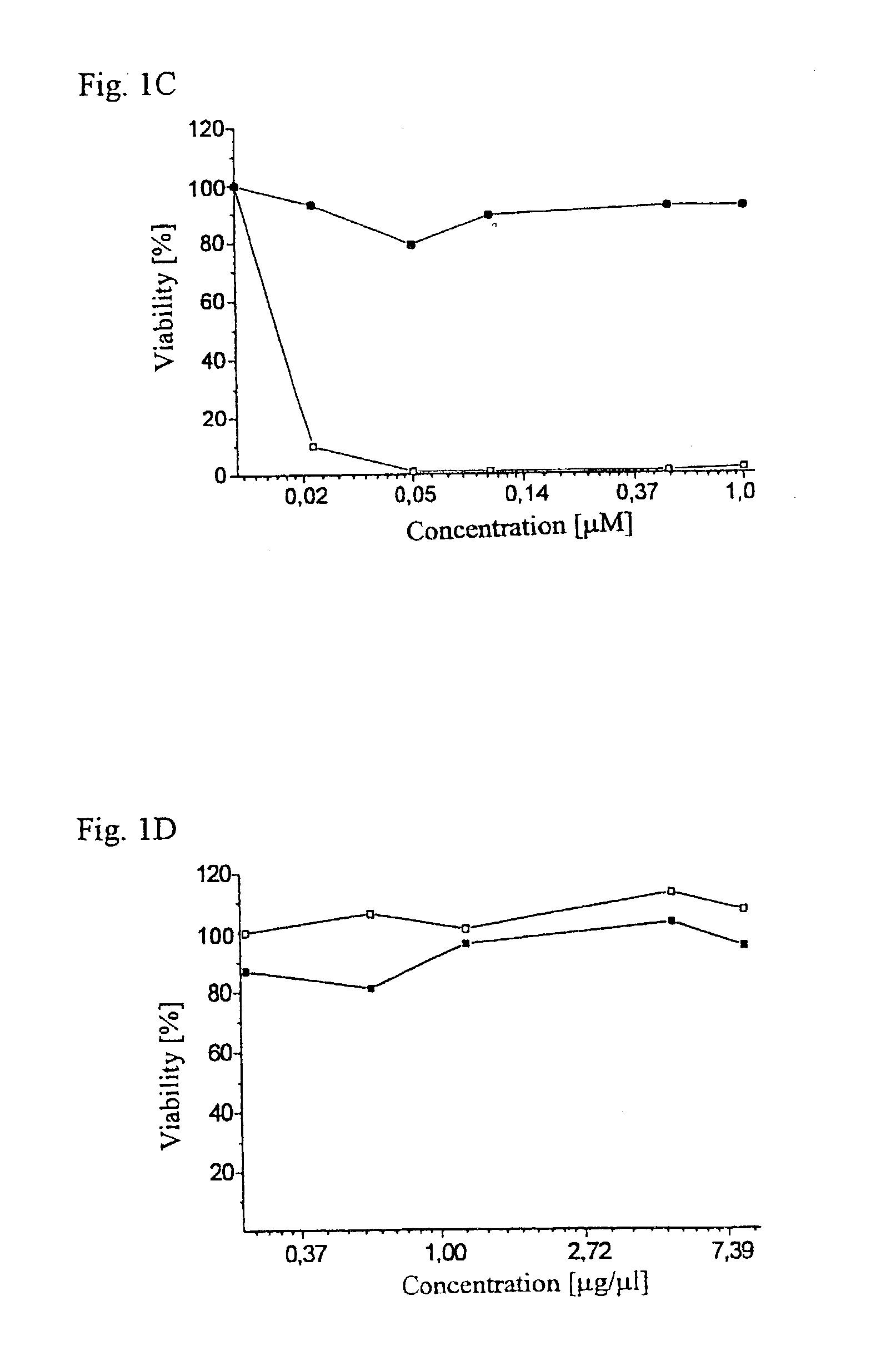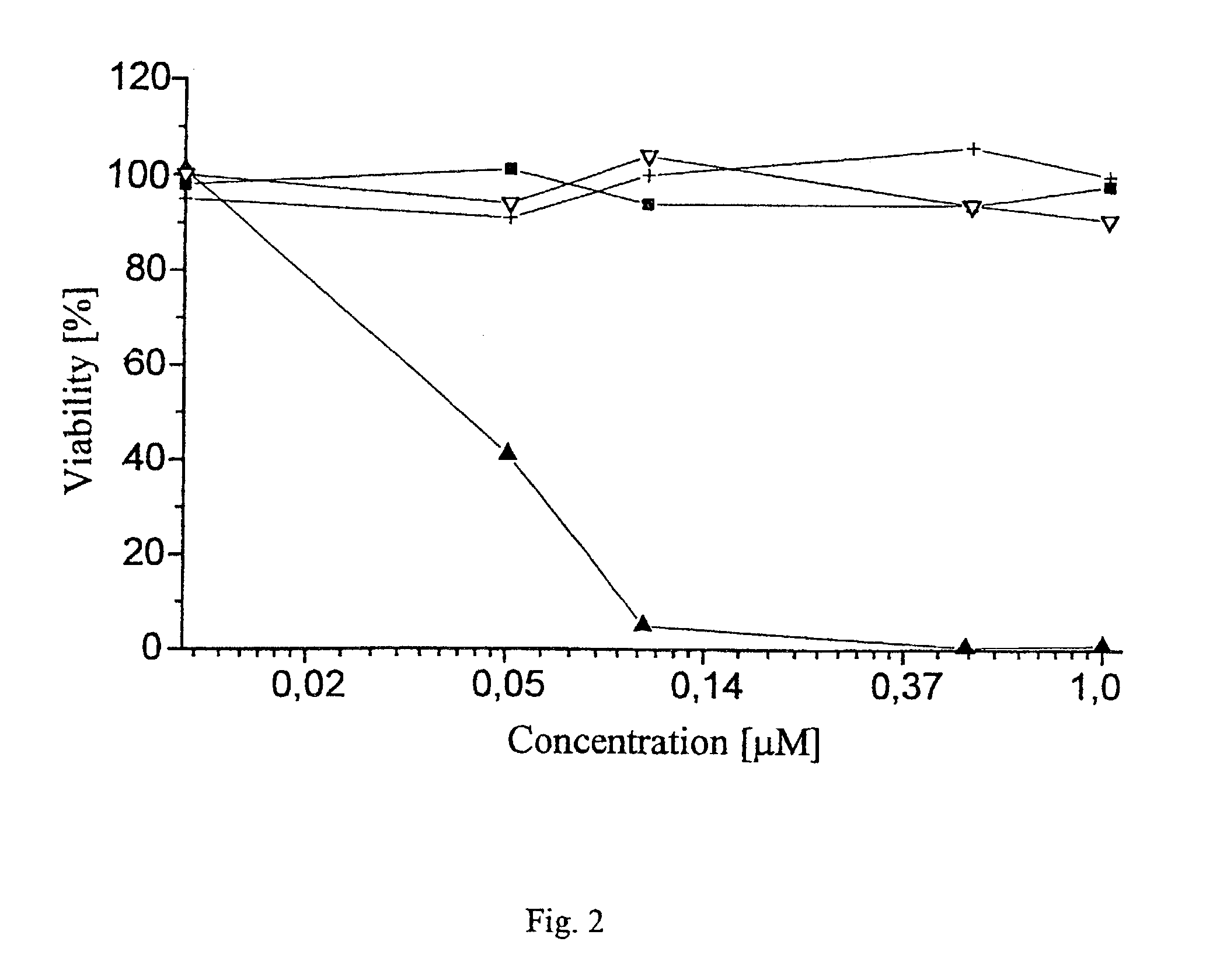Chlorophyll and bacteriochlorophyll esters, their preparation and pharmaceutical compositions comprising them
a technology which is applied in the field of derivatives of chlorophyll and bacteriochlorophyll, can solve the problems of less readily available and difficult to handle, and no method of chemical or enzymatic transesterification is availabl
- Summary
- Abstract
- Description
- Claims
- Application Information
AI Technical Summary
Benefits of technology
Problems solved by technology
Method used
Image
Examples
example 1
Preparation of 133-tert-butyl-benzyl-Pd-bacteriopheophorbide-a-173-methyl ester (tbb-Pd-BPheid-me) (R1-tbb; R2—CH3; M-Pd)
[0104]Following the general procedure (a) above, 3 mg of Pd-BPhe-me were reacted with 250 μl of para-tert-butylbenzyl alcohol (tbb). After 10 days, the main product tbb-Pd-BPheid-me was isolated in 65% yield after chromatography on silica with acetone / toluene 5:95 (v / v). The diester 133-tert-butylbenzyl-Pd-bacteriopheophorbide a-173-tert-butylbenzyl ester (tbb-Pd-BPheid-tbb) was isolated as a by-product.
[0105]Analytical data for tbb-Pd-BPheid-me:
[0106]tr=16.3 min on HPLC-system HII: rf=0.27 on silica with acetone / toluene=5:95 (v / v). UV / Vis: λmax [nm] (Arel) assignment=332 (0.67) By, 385 (0.53) Bx, 530 (0.19) Qx, 755 (1) Qy. 1H-NMR: δ [ppm] (multiplicity, assignment)=9.57 (s, 5-H), 8.67 (s, 10-H), 8.63 (s, 20-H), 7.48 and 7.28 (2 d, 3JA′B′=3JAB=4 Hz, o- and m-H of tbbat C-133), 6.52 (s, 132-H), 5.53 (s, 133-CH2), 4.37, 4.14, 4.11, 3.97 (4 m, 7-H, 8-H, 17-H and 18-H...
example 2
Preparation of 133-tert-butyl-benzyl-Pd-bacteriopheophytin-a-173-geranylgeranyl ester (tbb-Pd-BPhe-gg)
[0107]3 mg Pd-BPhe-gg was transesterified with 250 μl of para-tert-butylbenzyl alcohol (tbb). After 14 days at 75° C. tbb-Pd-BPhe-gg was isolated in 63% after chromatography on silica with acetone / toluene=5:95 (v / v).
[0108]Analytical data for tbb-Pd-BPhe-gg: tr=16.3 min on HPLC (silica, gradient 3–10% A in B, with A=toluene, B: toluene / methanol / n-propanol=100:4:0.5 (v / v / v), flow rate=1 ml / min); rf=0.63 on silica with acetone / toluene=5:95 (v / v).
[0109]UV / Vis: λmax [nm] (Arel, assignment)=332 (0.51 By), 384 (0.42, Bx), 528 (0.45, Qx), 756 (1, Qy). 1H-NMR: δ [ppm] (multiplicity, assignment)=9.58 (s, 5-H), 8.67 (s, 10-H), 7.49 and 7.24 (2m, o- and m-H of 133-tbb), 6.53 (s, 132-H), 5,54 (s, 133-CH2), 4.37, 4.14, 4.11, 3.97 (4m, 7-H, 8-H, 17-H and 18-H), 3.08 (s, 3-COCH3), 3.41 (s, 12-CH3), 3.39 (s, 2-CH3), 3.50 (s, 173-COOCH3), 4.61 (m, gg-OCH2), 5.15 (m, gg-OCH2—CH), 1.63 (s, gg-CH3), 2.5...
example 3
Preparation of 133-propyl-Pd-bacteriopheophytin-a-173-geranylgeranyl ester (pr-Pd-BPhe-gg)
[0110]6 mg Pd-BPhe-gg were transesterified with 1 ml of 1-propanol (prOH) in 20 ml THF. After 14 days at 75° C., pr-Pd-BPhe-gg was isolated in 60% yield after chromatography on silica with acetone / toluene=5:95 (v / v).
[0111]Analytical data for tbb-Pd-BPhe-gg: rf=0.44 on the system silica with acetone / toluene=5:95 (v / v).
[0112]UV / Vis: λmax [nm] (Arel, assignment)=332 (0,50, By), 384 (0,44. Bx), 528 (0,47, Qx), 756 (1, Qy). 1H-NMR: δ [ppm] (multiplicity, assignment)=9.59 (s, 5-H), 8.66 (s, 10-H), 6.53 (s, 132-H), 4.38, 3.90, 3.89, 3.97 (4 m 7-H, 8-H, 17-H and 18-H), 3.08 (31-COCH3), 3.42 (s, 12-H3), 3.39, (s, 2-CH3), 4.71 (m, gg-OCH2 at 173), 5.46 (m, gg-OCH2—CH at 173), 1.62 (s, gg-CH3 at 173), 2.59–1.98 (4 m, 171,2-CH2), 1.74–1.56 (m, propyl-OCH2CH2 at 133), 0.98 or 0.62 (m, propyl-CH3 at 133). MS (FAB) M+=1014.4 (calculated 1014.4 for C57H72N4O6106Pd), 927 (+−COO-pr).
PUM
 Login to View More
Login to View More Abstract
Description
Claims
Application Information
 Login to View More
Login to View More - R&D
- Intellectual Property
- Life Sciences
- Materials
- Tech Scout
- Unparalleled Data Quality
- Higher Quality Content
- 60% Fewer Hallucinations
Browse by: Latest US Patents, China's latest patents, Technical Efficacy Thesaurus, Application Domain, Technology Topic, Popular Technical Reports.
© 2025 PatSnap. All rights reserved.Legal|Privacy policy|Modern Slavery Act Transparency Statement|Sitemap|About US| Contact US: help@patsnap.com



